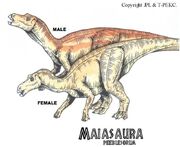Isla Sorna[]
Length: 30 feet

Illustration by T-PEKC of JPLegacy.
Height: 13 feet
Weight: 4 tons
Coloration:
- Male: A yellow body with a horizontal orange stripe across their flanks and an orange back.
- Female and juvenile (both sexes): A beige color with some light orange mottling.
Diet: Vegetation; typically tough fibrous plant material that can be chewed with its batteries of cheek teeth. Maiasaura is partial to conifer needles and cones.
Preferred Habitat: The conifer forests of the Southern Highlands, but can also be found on the Game Trail as well. This particularly shy species of hadrosaur much prefer more forested environments.
Social Structure: Close-knit herds.
Like all hadrosaurs, Maiasaura is nervous and constantly on the alert for danger. It lives in herds which often stampede as a defense mechanism.
Although these hadrosaurs are categorized as being “non-crested”, Maiasaura does in fact have a small pointed crest above the eyes. Despite its lack of an impressive crest akin to Parasaurolophus or Corythosaurus, Maiasaura is nonetheless just as vocal as these other species, producing loud, nasal bellows used both for communication (keeping the herd together) and to warn others of approaching danger.
Maiasaura's nesting and child-rearing behavior is even more refined than even the other hadrosaurs, which are renowned for being attentive parents. As opposed to the other species of hadrosaur, which nest in multiple species colonies on the Game Trail, Maiasaura keep theirs within its own kind, preferring to nest in the forests of the Southern Highlands. Eggs are laid in mounds of dirt and are carefully incubated with vegetation. Each parent will pitch in to guard their own nest while taking it in turns to feed.
Due to this species' dedication to its offspring, it is usually virtually impossible to separate a Maiasaura parent from its nest. Small egg raiders are shooed away by a bellow or a warning snap of the beak, and even in the face of a larger predator a parent will still refuse to budge. It will attempt to defend its young - sometimes to the death. If a parent is killed, the nest-bound young are significantly more vulnerable. Unless both the parents die, the young still have a chance of survival especially if they are no longer confined to the nest. Orphaned juveniles which are capable of moving about independently may be adopted by another member of the herd.
Soon enough, the offspring are old enough to travel with the rest of the herd. Even in a large family herd, the young can recognize their own parent/s by the pitch of their calls, and vice versa.